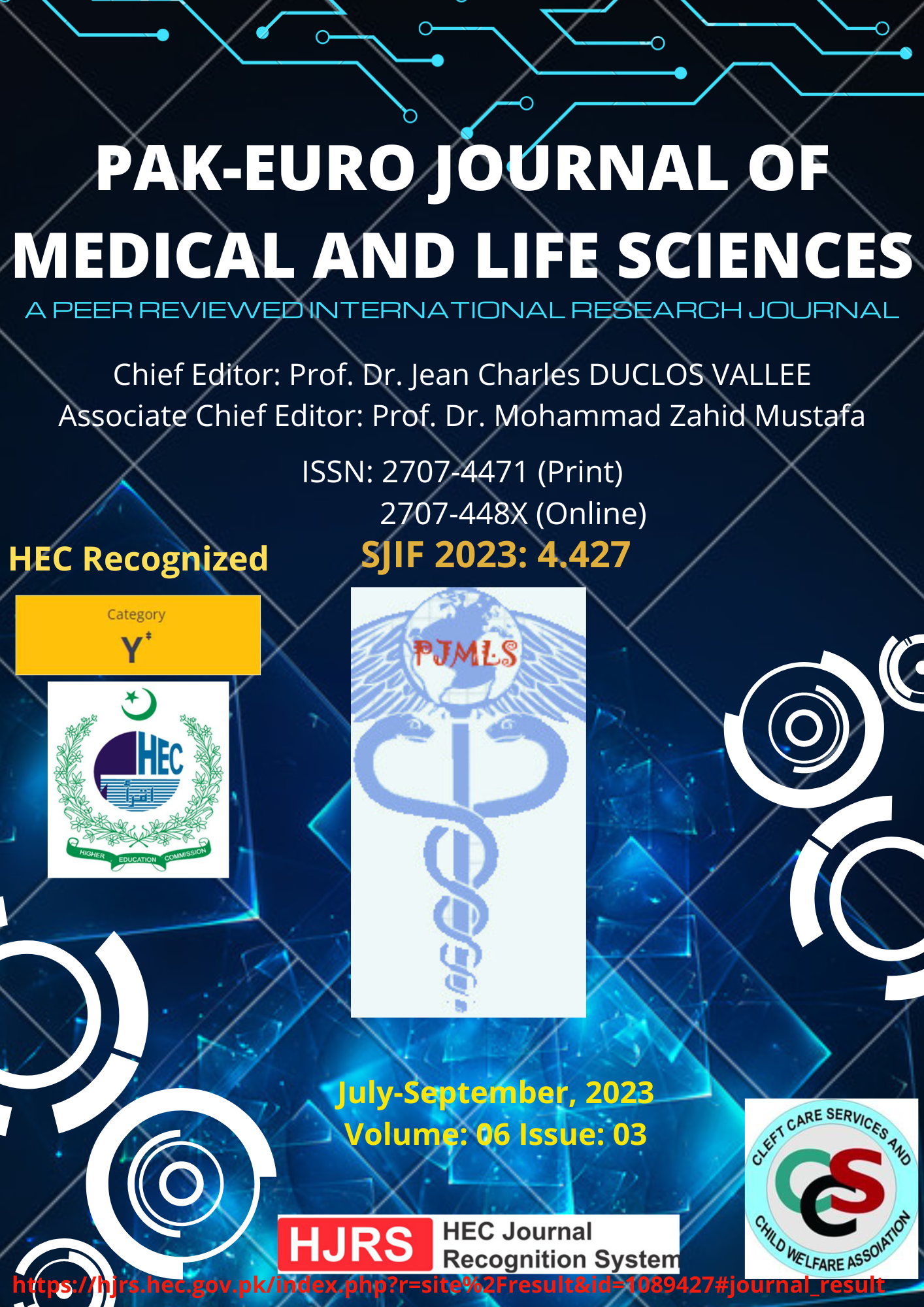Consequences of Urine and Sexual Behavior after Posterior Urethral Distraction Defect Repair under Anesthesia
DOI:
https://doi.org/10.31580/gzpejg78Keywords:
Posterior urethral distraction defect, Urinary function, Sexual behavior, Voiding functions, Sexual outcomesAbstract
Background: Posterior urethral distraction deficits provide a complex clinical situation that often requires surgical intervention for reconstruction. These conditions might potentially occur as a result of traumatic accidents, strictures, or congenital abnormalities, hence presenting notable obstacles to the proper functioning of the urinary system.
Aim: The aim of this study is to the consequences of urine and sexual behaviour after posterior urethral distraction defect repair under anaesthesia.
Study Design: This is a prospective design study.
Duration and Place of the Study: This study was conducted at the Department of Urology, Hayatabad Medical Complex Peshawar between Jan 2021 and Jan 2022.
Material and Methods: The study included 100 male patients who underwent anaesthesia for posterior urethral distraction defect correction. Every participant in this study gave informed consent, which included detailed information about the study's objectives, methodology, and potential risks. A full collection of pre-operative data was collected, including demographic information, medical history, and first urine and sexual function examinations.
Results: There were 100 patients, with an average age of 45±8 years. Most of the patients were Asian (80%), followed by Caucasian (10%) and others (10%). The occupations were 30% professionals, 40% skilled workers, and 30% unskilled. A quarter of participants had comorbidities, 40% smoked, and 60% were non-smokers. patients had an average BMI of 26±3.
Conclusion: A significant proportion of the patients reported experiencing enhanced voiding patterns and urine flow rates, with improvements in libido and sexual satisfaction after the surgical intervention.
References
Gelman J. Tips for successful open surgical reconstruction of posterior urethral disruption injuries. Urologic Clinics. 2013;40(3):381-92.
Lazzeri M, Sansalone S, Guazzoni G, Barbagli G. Incidence, causes, and complications of urethral stricture disease. European Urology Supplements. 2016;15(1):2-6.
Melekos MD, Naber KG. Complicated urinary tract infections. International journal of antimicrobial agents. 2000;15(4):247-56.
Clayton A, Ramamurthy S. The impact of physical illness on sexual dysfunction. Sexual Dysfunction. 2008;29:70-88.
Marinkovic SP, Badlani G. Voiding and sexual dysfunction after cerebrovascular accidents. The Journal of urology. 2001;165(2):359-70.
Basson R. The optimal discipline for assessing and managing pain during sex. Archives of Sexual Behavior. 2005;34(1):23.
Ríos E, Martínez-Piñeiro L. Treatment of posterior urethral distractions defects following pelvic fracture. Asian J Urol. 2018;5(3):164-171.
Meana M. Teasing apart the pain from the sex: Is the pendulum swinging too far?. Archives of Sexual Behavior. 2005;34(1):42.
Burnett AL, Nehra A, Breau RH et al: Erectile dysfunction: AUA guideline. J Urol 2018; 200: 633.
Filipescu D, Ştefan M. Sex and gender differences in anesthesia: Relevant also for perioperative safety?. Best Practice & Research Clinical Anaesthesiology. 2021;35(1):141-53.
Hughes IA, Houk C, Ahmed SF, Lee PA, Society LW. Consensus statement on management of intersex disorders. Journal of pediatric urology. 2006;2(3):148-62.
Abrams P, Andersson KE, Birder L, Brubaker L, Cardozo L, Chapple C, Cottenden A, Davila W, De Ridder D, Dmochowski R, Drake M. Fourth International Consultation on Incontinence Recommendations of the International Scientific Committee: Evaluation and treatment of urinary incontinence, pelvic organ prolapse, and fecal incontinence. Neurourology and Urodynamics: Official Journal of the International Continence Society. 2010;(1):213-40.
Morey AF, McAninch JW. Reconstruction of posterior urethral disruption injuries: outcome analysis in 82 patients. The Journal of urology. 1997;157(2):506-10.
Flynn BJ, Delvecchio FC, Webster GD. Perineal repair of pelvic fracture urethral distraction defects: experience in 120 patients during the last 10 years. The Journal of urology. 2003;170(5):1877-80.
Gorde VA, Date J, Shivde S, Kashyapi B, Joshi P, Sholapurkar A. MODERATED POSTERS-USICON 2008: SESSION: PARALLEL SESSIONS (AFTER-NOON), HALL: D, TIME: 2: 30 PM to 4: 00 PM, DATE: 18.1. 2008, 19.1. 2008. Indian Journal of Urology. 2008;24(Suppl 5):S30-41.
Kirby M, Chapple C, Jackson G, Eardley I, Edwards D, Hackett G, Ralph D, Rees J, Speakman M, Spinks J, Wylie K. Erectile dysfunction and lower urinary tract symptoms: a consensus on the importance of co‐diagnosis. International journal of clinical practice. 2013;67(7):606-18.
Harvey-Kelly KF, Kanakaris NK, Obakponovwe O, West RM, Giannoudis PV. Quality of life and sexual function after traumatic pelvic fracture. Journal of orthopaedic trauma. 2014;28(1):28-35.
Downloads
Published
Issue
Section
License
Copyright (c) 2023 Pak-Euro Journal of Medical and Life Sciences

This work is licensed under a Creative Commons Attribution 4.0 International License.






